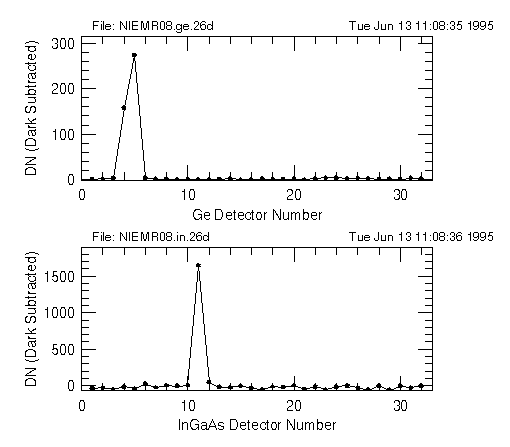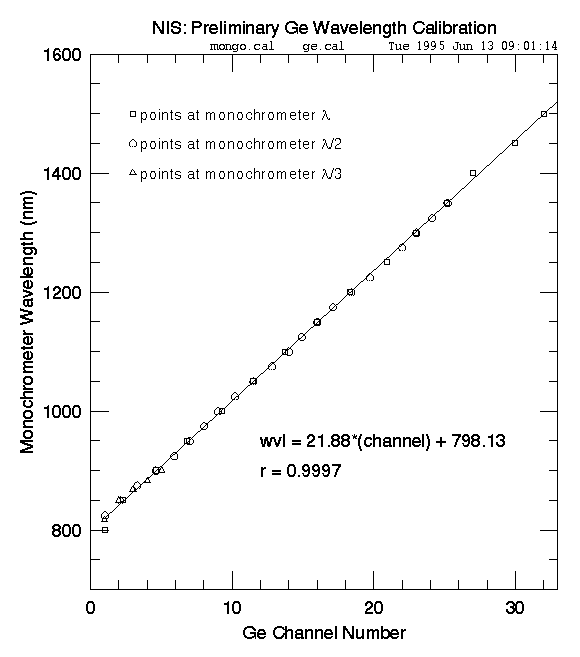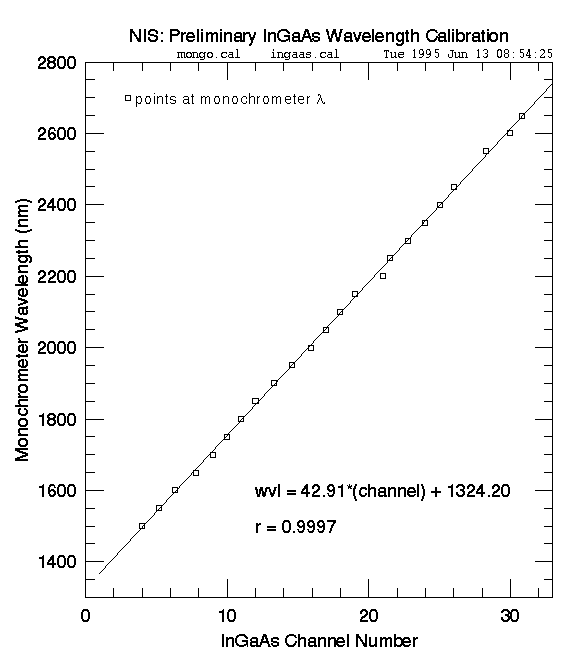InGaAs SNR Analysis
NIS Calibration Report #6
Jim Bell; 6/13/95
Issue:
Preliminary wavelength calibration of Ge and InGaAs detectors
Methods:
(1) Use the May 13-15 OCF data for NIS placed on retro by Scott.
In particular, examine the file NIEMR08.134, which are spectra acquired
by stepping the monochrometer through the Ge and InGaAs spectral ranges,
at room temperature and in air.
(2) Calculate averages and standard deviations of all 10 measurements in each
block of data, and plot the results to verify data quality.
(3) Subtract an averaged dark spectrum from each average created in (2).
An example spectrum acquired with NIS with the monochrometer set at 1800 nm
is shown in Figure 1 below:
 Figure 1: NIS spectrum of a narrow 1800 nm line produced by the monochrometer.
The top panel is the Ge detector, the bottom in InGaAs. The line shows up
at channel 11.0 of the InGaAs detector, and also at channel 4.6 of the
Ge detector because no order sorting filter was used, and thus second-order
monochrometer light (at 900 nm, in this case), was seen by the Ge detector.
Figure 1: NIS spectrum of a narrow 1800 nm line produced by the monochrometer.
The top panel is the Ge detector, the bottom in InGaAs. The line shows up
at channel 11.0 of the InGaAs detector, and also at channel 4.6 of the
Ge detector because no order sorting filter was used, and thus second-order
monochrometer light (at 900 nm, in this case), was seen by the Ge detector.
(4) Calculate the peak values of the lines seen in the spectra, and generate
a plot of peak channel number versus input monochrometer wavelength.
Results:
Ge Detector:
The preliminary wavelength calibration results for the Ge detector, along
with the best-fit calibration equation, are shown in Figure 2 below. Along
with input wavelengths at each monochrometer wavelength, extra lines were
observed for Ge at one-half and one-third of the monochrometer wavelengths
because the order-sorting filter was not used in these measurements.
 Figure 2: Wavelength calibration for the NIS Ge detector, in air at room
temperature.
Figure 2: Wavelength calibration for the NIS Ge detector, in air at room
temperature.
InGaAs Detector:
The preliminary wavelength calibration results for the InGaAs detector, along
with the best-fit calibration equation, are shown in Figure 3 below.
 Figure 3: Wavelength calibration for the NIS InGaAs detector, in air at room
temperature.
Figure 3: Wavelength calibration for the NIS InGaAs detector, in air at room
temperature.
Summary and Additional Work:
A good estimate of the wavelength calibration can be derived using the May
OCF test data, especially for the Ge detector. However, there are some
important caveats:
(a) A single averaged dark spectrum was subtracted from all the measurements,
and so the drifts of the dark current with time (which are evident in the
data) have not been considered.
(b) No flatfielding has been done, so pixel-to-pixel variability, which will
effect the apparent profile of the monochrometer lines, has not been removed.
(c) No consideration of the profile of the monochrometer line has been done.
(d) The peak channel from each line has been determined only to about 0.1
channels; it could be done much better after (a) through (c) have been
factored in to a more rigorous analysis.
(e) The same analysis needs to be performed for the data acquired in vacuum
and at low (flight) temperature, in order to determine the final NIS wavelength
calibration.
 Figure 1: NIS spectrum of a narrow 1800 nm line produced by the monochrometer.
The top panel is the Ge detector, the bottom in InGaAs. The line shows up
at channel 11.0 of the InGaAs detector, and also at channel 4.6 of the
Ge detector because no order sorting filter was used, and thus second-order
monochrometer light (at 900 nm, in this case), was seen by the Ge detector.
Figure 1: NIS spectrum of a narrow 1800 nm line produced by the monochrometer.
The top panel is the Ge detector, the bottom in InGaAs. The line shows up
at channel 11.0 of the InGaAs detector, and also at channel 4.6 of the
Ge detector because no order sorting filter was used, and thus second-order
monochrometer light (at 900 nm, in this case), was seen by the Ge detector.
 Figure 2: Wavelength calibration for the NIS Ge detector, in air at room
temperature.
Figure 2: Wavelength calibration for the NIS Ge detector, in air at room
temperature.
 Figure 3: Wavelength calibration for the NIS InGaAs detector, in air at room
temperature.
Figure 3: Wavelength calibration for the NIS InGaAs detector, in air at room
temperature.